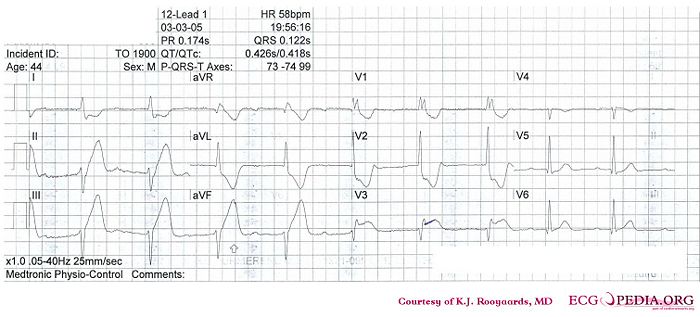Answer MI 17: Difference between revisions
Jump to navigation
Jump to search
m Example 6 moved to Answer MI 17 |
No edit summary |
||
| (2 intermediate revisions by 2 users not shown) | |||
| Line 1: | Line 1: | ||
[[Image:KJcasus6.jpg|thumb| | {{Case| | ||
|previouspage= MI 16 | |||
|previousname= MI 16 | |||
|nextpage=MI 18 | |||
|nextname=MI 18 | |||
}} | |||
'''Where is this myocardial infarction located?''' | |||
[[Image:KJcasus6.jpg|700px|thumb|left|ECG MI 17. Click on image for enlargement.]] | |||
{{clr}} | |||
==Answer== | |||
* Following the 7+2 steps: | * Following the 7+2 steps: | ||
**Rhythm | **Rhythm | ||
| Line 20: | Line 30: | ||
'''Inferior-posterior myocardial infarction with complete AV block and ventricular excape rhythm with RBBB pattern and left axis, followed by sinus-rhythm. Probably RCA occlusion (ST depression in I)''' | '''Inferior-posterior myocardial infarction with complete AV block and ventricular excape rhythm with RBBB pattern and left axis, followed by sinus-rhythm. Probably RCA occlusion (ST depression in I)''' | ||
{{clr}} | {{clr}} | ||
Latest revision as of 20:22, 29 March 2012
| This page is part of Cases and Examples |
Where is this myocardial infarction located?

Answer
- Following the 7+2 steps:
- Rhythm
- In leads V1 to V3 there is apparantly no relationship between the P waves and the QRS complexes. Furthermore the QRS complexes are broad and have a RBBB pattern (V1:RSR), thus the rhythm is probably a ventricular escape rhythm. Leads V4-V6 however show a narrow complex preced by a P wave, probably the result of a rhythm change to sinus rhythm.
- Hartfrequency
- Use the 'count the squares' method (a bit less than 3 large squares ~> 300-150-100), thus about 58 bpm.
- Conduction (PQ,QRS,QT)
- During sinus beats: PQ-interval=250msec, QRS duration=0.11sec, QT interval=400ms (equals QTc at this rate). The wide complexes have a QRS duration of +- 160 ms.
- Heartaxis
- Negative in AVF and II, thus a left axis deviation.
- P wave morphology
- The p wave is rather difficult to discern. It seems normal in V4-V6 and positive in AVF and negative in AVR.
- QRS morphology
- RBBB pattern in V1 with ST changes (depression precordial leads). Leads V3 and V4 have probably been poled to the right chest. No pathologic Q waves.
- ST morphology
- ST elevation in II,III, and AVF and also in V3 (V3right). Hyperacute T waves with ST depression in V1-V2 an I, AVR and AVL.
- Compare with the old ECG (not available, so skip this step)
- Conclusion?
- Rhythm
Inferior-posterior myocardial infarction with complete AV block and ventricular excape rhythm with RBBB pattern and left axis, followed by sinus-rhythm. Probably RCA occlusion (ST depression in I)